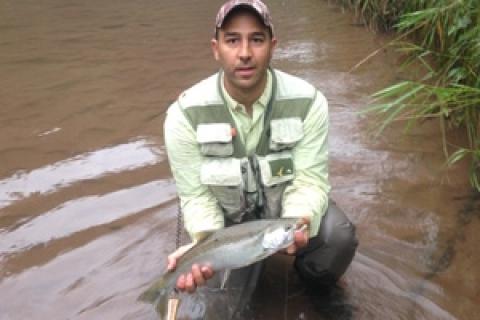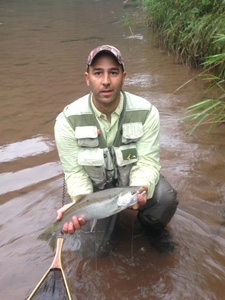
 As the fall cold weather takes hold, the desire to hunt among outdoorsmen leaves rivers and streams vacant. This lack of attention by anglers is by no means any indication of how productive Great Lakes tributaries can be this time of year. While the timing of the salmon runs to each river differ, you can count on these fish making their respected journeys sometime near the end of September.
As the fall cold weather takes hold, the desire to hunt among outdoorsmen leaves rivers and streams vacant. This lack of attention by anglers is by no means any indication of how productive Great Lakes tributaries can be this time of year. While the timing of the salmon runs to each river differ, you can count on these fish making their respected journeys sometime near the end of September.
The hardest part to fishing the salmon runs is finding the fish. In most cases you can't see fish running up the river or feeding like trout do on the surface. You have to believe they are there hiding in the runs and structure. When the bite is on catching fish can be easy, but when salmon become skittish it will make you second guess their presence in the river.
To target salmon in the river the first rule of thumb is to get on the water by sunrise. Salmon are especially cautious on bright sunny days and will be hard to find as the sun gets high in the sky. If the weather is overcast you can fish comfortably into the afternoon and still see good action.
These fish seem to be most aggressive in the early morning, and multiple fish can be caught out of the same run. Look for deep slow holes/runs that have bank cover or submerged wood/rocks. Fish these holes from the back to the front in a slow methodical fashion. Make sure you are getting baits down deep as close to the bottom as possible. Salmon, for the most part, do not feed once they enter rivers. To get fish to bite you have to present your baits close enough to where the fish are laying to elicit an aggression strike. Streamers such as rabbit strip leeches, zonker minnows and deceivers all work this time of year and inline spinners such as Mepps Aglias (size 3 and 4) also hook plenty of fish.
Although most anglers concentrate on the rivers in early spring, one of the best times to target salmon is in the fall. Anglers should watch the weather and when the rains come follow the fish as they move up the river.
- 3808 views

